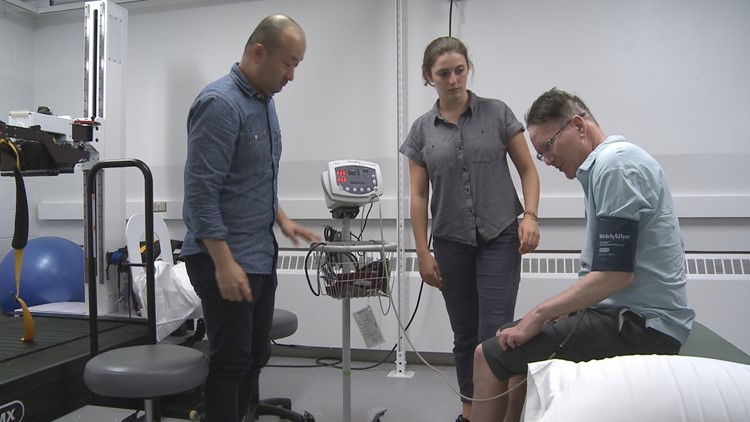There have been several breakthroughs using electrical stimulation to damaged nerves, but they have required surgeries to implant wires and stimulator inside the body.
At the University of Washington, they are showing dramatic success with a much less invasive procedure.
“In six months’ time, I flew over 150,000 miles. I snorkeled in the Red Sea, sat on the Great Wall of China, and attended Octoberfest,” Joe recalled.
It was during that active life body-surfing in Hawaii when Joe was tumbled onto the beach by a rogue wave that left him with a spine injury and a future life without the use of his limbs.
“The only thing I could move when I woke up was my big toe, so it means I wasn’t totally paralyzed,” Joe explained. “I was in the hospital for three weeks.”
“Spinal cord injuries are a very compelling problem because there are very few or essentially no clinical treatments for those with chronic spinal cord injuries,” explained Dr. Moritz.
Dr. Moritz and his team at UW’s Center for Neurotechnology are working on a study funded by the National Science Foundation that would attempt to reconnect or rebuild severed electrical pathways from the brain to the body’s uncontrollable extremities, with non-invasive electrical stimulation.
“From day one it was, ‘what do I need to do to help him get his as healthy and as better as he can,’” said Joe’s son, Austin Beatty.
Joe now lives with his son who provides care for his father. Austin shares his father’s feeling that this new trial can improve his dad’s health and bring hope to others.
“Now it's turned out that the study was like, OK we have an opportunity for a breakthrough that can help millions of people, not just us,” said Austin.
When KING 5 visited, Joe’s therapy focused on improving his finger dexterity.
“I take pills throughout the day and night, so now instead of having to wake up my son I can take them myself,” said Joe.
“He had a difficult time to feed himself, grabbing things, grasping utensils, grasping food,” Austin explained. “Now he still has limited movement in his fingers but it's improved where he can grab sandwiches, he can grab a remote, he can grab his cell phone.”
The physical therapy combined with transcutaneous spinal stimulation has affected the way Joe looks at the world.
“What’s happening is my muscles are being stimulated through this device. It really sort of helps my movement,” said Joe.
“The current theory is that we are stimulating the spinal cord electrically, using a fancy waveform that allows that energy to pass through the skin painlessly and activate the spinal circuits. And then that activation of the spinal circuits in combination with Joe's attempts to move generated by his brain activity is what results in his initial ability to move when he might otherwise not be able to,” explained Dr. Moritz. “Now, what leads to long-term improvements, we're much less sure about. But there is evidence of what we call neuroplasticity or changes in the connections between neurons in the brain and the spinal cord. And we believe that by practicing activities with the stimulator running, Joe is able to actually change the wiring between his brain and his spinal cord and that what leads to long-term improvements.”
“You saw me walk out here, six months ago there was no way I could do it. So now I’m on the treadmill walking, on the cardiac walker, I’ll do eight minutes straight. I couldn’t do that months ago,” said Joe.
“Joe's drive, his motivation, is clearly helping him to improve both in our study as well as in the rest of his life,” said Dr. Moritz.
The study has plans to expand into four other states to reach more patients.
The ultimate goal is to have these stimulation units available to take home so people can have ongoing treatment and see an improvement to their physical abilities regaining their life independence.



